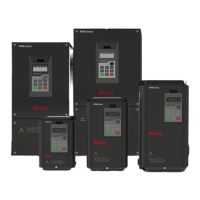Introductions to functions listed in Table 6-1:
1: Forward.
2: Reverse.
3~4: Forward/reverse jog operation.
They are used jog control of terminal control mode.
The jog operation frequency, jog interval and jog
Acc/Dec time are defined by A2.04~A2.05, A4.05~
A4.06.
5: 3-wire operation control.
They are used in operation control of terminal
control mode. Refer to A6.09.
6: External RESET signal input.
The drive can be reset via this terminal when the
drive has a fault. The function of this terminal is the
same with that of RST on the panel.
7: External fault signal input.
If the setting is 7, the fault signal of external
equipment can be input via the terminal, which is
convenient for the drive to monitor the external
equipment. Once the drive receives the fault signal,
it will display “E015”.
8: External interrupt signal input
If the setting is 8, the terminal is used to cut off the
output and the drive operates at zero frequency
when the terminal is enabled. If the terminal is
disabled, the drive will start on automatically and
continue the operation.
9: Drive operation prohibit.
If terminal is enabled, the drive that is operating will
coast to stop and is prohibited to restart. This
function is mainly used in application with
requirements of safety protection.
10: External stop command.
This stopping command is active in all control
modes. When terminal 35 is enabled, the drive will
stop in the mode defined in A1.05.
11: DC injection braking command.
If the setting is 11, the terminal can be used to
perform DC injection braking to the motor that is
running so as to realize the emergent stop and
accurate location of the motor. Initial braking
frequency, braking delay time and braking current
are defined by A1.06~A1.08. Braking time is the
greater value between A1.09 and the effective
continuous time defined by this control terminal.
12: Free to stop.
If the setting is 12, the function of the terminal is the
same with that defined by A1.05. It is convenient for
remote control.
13~14: Frequency ramp UP/DN.
If the setting is 13~14, the terminal can be used to
increase or decrease frequency. Its function is the
same with ▲ and ▼ keys on the panel, which
enables remote control. This terminal is enabled
when A0.02=0 and A0.04=1. Increase or decrease
rate is determined by A2.02 and A2.03.
15: Switch to panel control.
It is used to set the control mode as panel control.
16: Switch to terminal control
It is used to set the control mode as terminal
control.
17: Reserved.
18: Main reference frequency via AI1
19: Main reference frequency via AI2
20: Main reference frequency via Keyboard
Potentiometer
21: Main reference frequency via DI
Main reference frequency will switch to set via
AI1,AI2, Keyboard Potention or DI when the
terminal activate.
22: Auxiliary reference frequency invalid.
Auxiliary reference frequency is invalid when the
terminal activate.
23~26: Reserved.
27~30: Preset frequency selection.
Up to 15 speed references can be set through
different

